ECON11026 Term 1: Australia's Macroeconomic Environment Analysis
VerifiedAdded on 2023/01/11
|15
|3308
|57
Essay
AI Summary
This essay provides a comprehensive analysis of the current macroeconomic environment in Australia, evaluating key indicators such as GDP growth, unemployment, and inflation. It delves into the Australian economic performance, comparing it with regional and global averages, and examines the nation's business cycle stage, currently identified as expansionary. The paper explores macroeconomic goals, including income distribution, balance of payments, full employment, sustainable economic growth, and low inflation, highlighting how fiscal policy tools, such as government expenditure and taxation, are used to influence economic growth. Expansionary and contractionary fiscal policies are discussed, along with their effects on aggregate demand and output. The essay further examines the proposed infrastructure spending and tax cuts in Australia, analyzing their supply-side effects and the multiplier process, offering insights into how these fiscal measures can impact the economy's performance and stability. The analysis is supported by references to relevant economic literature and government reports.
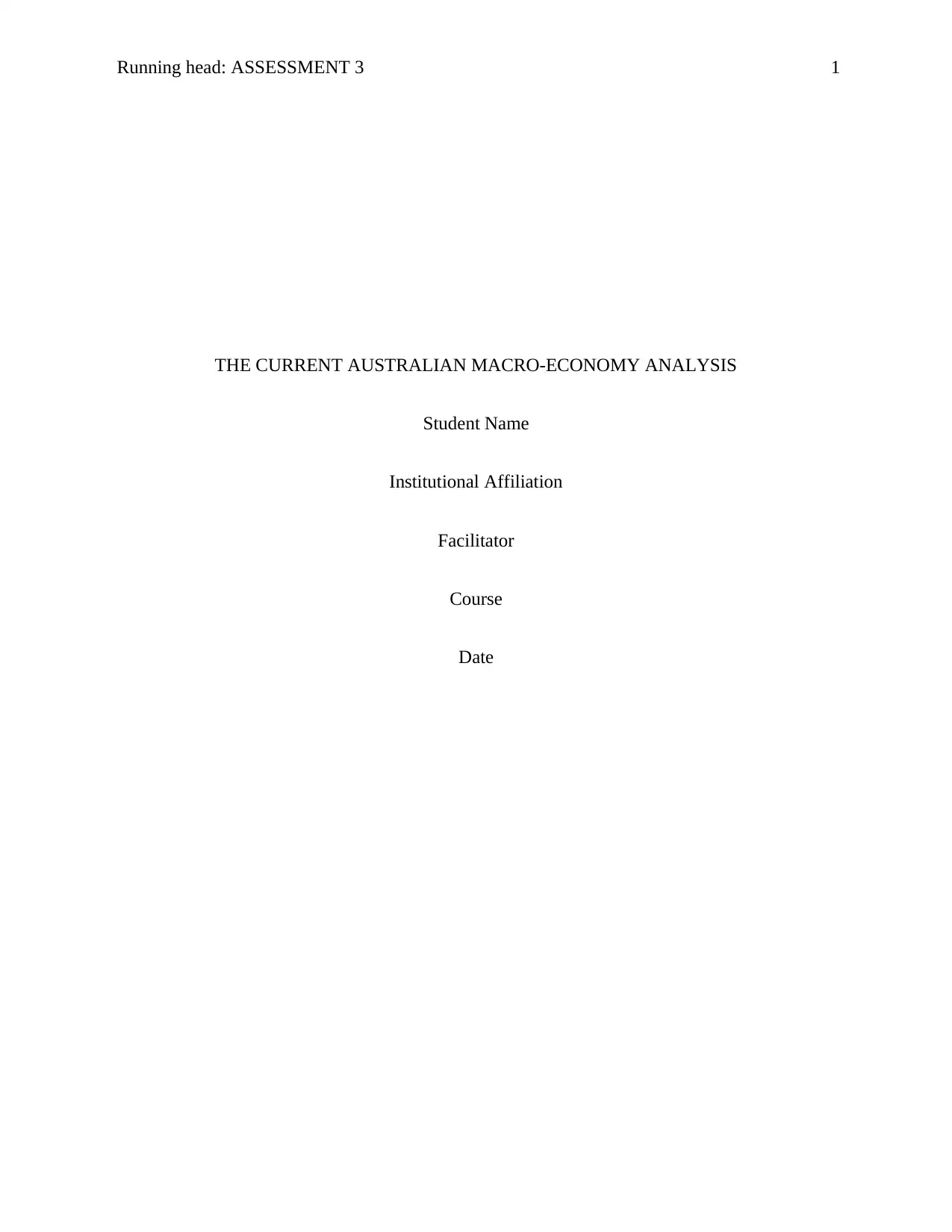
Running head: ASSESSMENT 3 1
THE CURRENT AUSTRALIAN MACRO-ECONOMY ANALYSIS
Student Name
Institutional Affiliation
Facilitator
Course
Date
THE CURRENT AUSTRALIAN MACRO-ECONOMY ANALYSIS
Student Name
Institutional Affiliation
Facilitator
Course
Date
Paraphrase This Document
Need a fresh take? Get an instant paraphrase of this document with our AI Paraphraser

ASSESSMENT 3 2
“Discuss the current macroeconomic environment in Australia whilst critically evaluating the
role of fiscal policy as a stabilization tool”
Introduction
Australia has been ranked among the wealthiest nations in the region of Asia-Pacific and
also in the whole world. The nation’s economy has undergone expansion for more than two
decades uninterrupted. Australia has shown great resilience to economic challenges which could
severely harm its economy and the nation was even able to undergo a positive economic growth
during the great recession of the year 2008 to 2009 despite many nations posting negative
economic growth (McDonald & Morling, 2011).
The current Australian macro-economy has been analyzed and its fiscal policy role in
stabilizing the economic evaluated in this report. It is crucial to assess a nation’s macro-economy
based on various indicators such as unemployment level, gross domestic product growth rate,
inflation, and interest rates as well as macroeconomic policies which include the fiscal and
monetary policy. The macroeconomic assessment reveals crucial information on various
highlighted indicators which enables budgeting by the government, businesses, and individuals
as well as investors who have an interest in investing in the economy. Sound future decisions can
be made by the mentioned parties with great certainty. The economic performance can also be
compared with that of other nations and past years’ performance history to ascertain an
economy’s progress. It is important therefore to evaluate a nation’s macro-economy so as
forecast future decisions and tailor macroeconomic policies towards achieving the desired
macroeconomic goals.
An Overview of the Current Australian Economic Environment
“Discuss the current macroeconomic environment in Australia whilst critically evaluating the
role of fiscal policy as a stabilization tool”
Introduction
Australia has been ranked among the wealthiest nations in the region of Asia-Pacific and
also in the whole world. The nation’s economy has undergone expansion for more than two
decades uninterrupted. Australia has shown great resilience to economic challenges which could
severely harm its economy and the nation was even able to undergo a positive economic growth
during the great recession of the year 2008 to 2009 despite many nations posting negative
economic growth (McDonald & Morling, 2011).
The current Australian macro-economy has been analyzed and its fiscal policy role in
stabilizing the economic evaluated in this report. It is crucial to assess a nation’s macro-economy
based on various indicators such as unemployment level, gross domestic product growth rate,
inflation, and interest rates as well as macroeconomic policies which include the fiscal and
monetary policy. The macroeconomic assessment reveals crucial information on various
highlighted indicators which enables budgeting by the government, businesses, and individuals
as well as investors who have an interest in investing in the economy. Sound future decisions can
be made by the mentioned parties with great certainty. The economic performance can also be
compared with that of other nations and past years’ performance history to ascertain an
economy’s progress. It is important therefore to evaluate a nation’s macro-economy so as
forecast future decisions and tailor macroeconomic policies towards achieving the desired
macroeconomic goals.
An Overview of the Current Australian Economic Environment
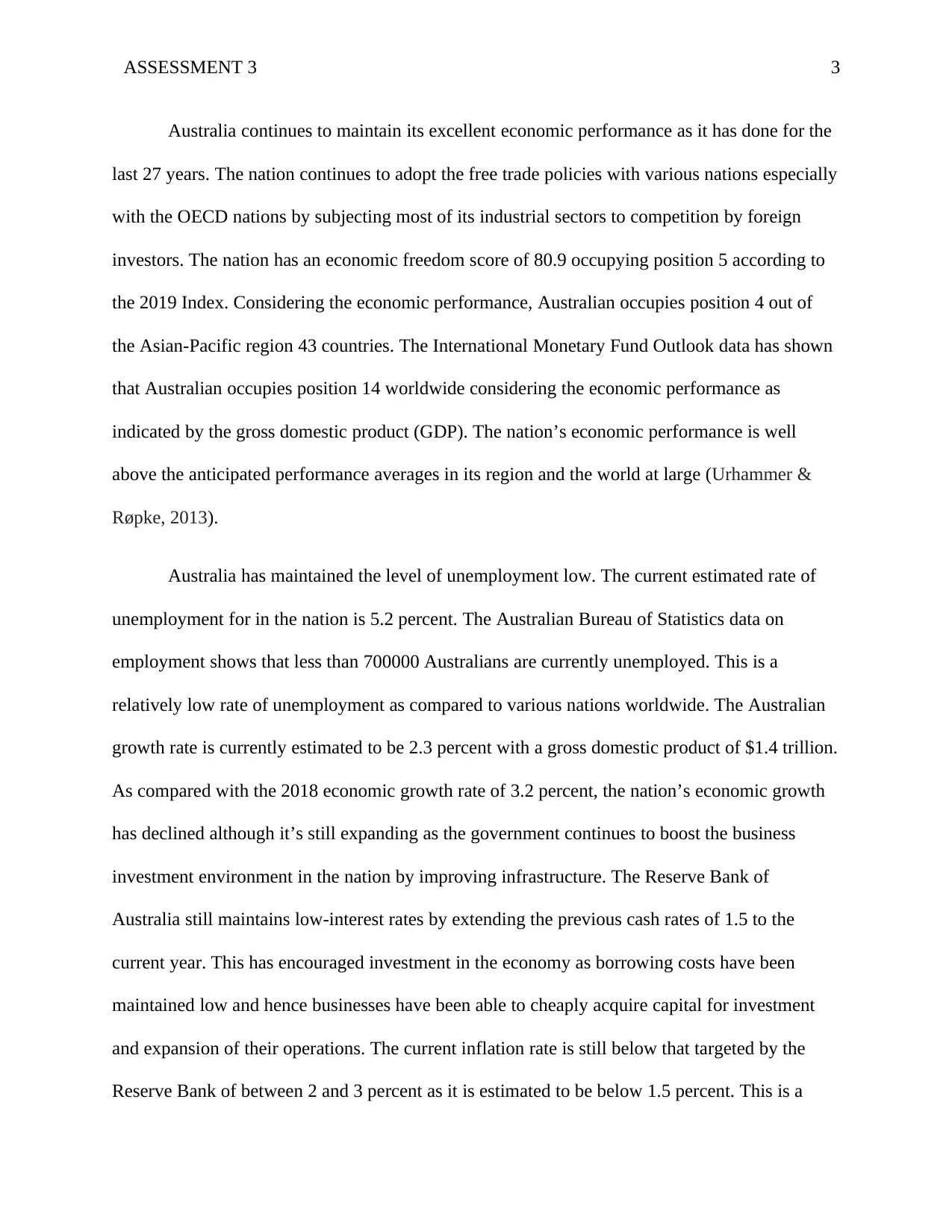
ASSESSMENT 3 3
Australia continues to maintain its excellent economic performance as it has done for the
last 27 years. The nation continues to adopt the free trade policies with various nations especially
with the OECD nations by subjecting most of its industrial sectors to competition by foreign
investors. The nation has an economic freedom score of 80.9 occupying position 5 according to
the 2019 Index. Considering the economic performance, Australian occupies position 4 out of
the Asian-Pacific region 43 countries. The International Monetary Fund Outlook data has shown
that Australian occupies position 14 worldwide considering the economic performance as
indicated by the gross domestic product (GDP). The nation’s economic performance is well
above the anticipated performance averages in its region and the world at large (Urhammer &
Røpke, 2013).
Australia has maintained the level of unemployment low. The current estimated rate of
unemployment for in the nation is 5.2 percent. The Australian Bureau of Statistics data on
employment shows that less than 700000 Australians are currently unemployed. This is a
relatively low rate of unemployment as compared to various nations worldwide. The Australian
growth rate is currently estimated to be 2.3 percent with a gross domestic product of $1.4 trillion.
As compared with the 2018 economic growth rate of 3.2 percent, the nation’s economic growth
has declined although it’s still expanding as the government continues to boost the business
investment environment in the nation by improving infrastructure. The Reserve Bank of
Australia still maintains low-interest rates by extending the previous cash rates of 1.5 to the
current year. This has encouraged investment in the economy as borrowing costs have been
maintained low and hence businesses have been able to cheaply acquire capital for investment
and expansion of their operations. The current inflation rate is still below that targeted by the
Reserve Bank of between 2 and 3 percent as it is estimated to be below 1.5 percent. This is a
Australia continues to maintain its excellent economic performance as it has done for the
last 27 years. The nation continues to adopt the free trade policies with various nations especially
with the OECD nations by subjecting most of its industrial sectors to competition by foreign
investors. The nation has an economic freedom score of 80.9 occupying position 5 according to
the 2019 Index. Considering the economic performance, Australian occupies position 4 out of
the Asian-Pacific region 43 countries. The International Monetary Fund Outlook data has shown
that Australian occupies position 14 worldwide considering the economic performance as
indicated by the gross domestic product (GDP). The nation’s economic performance is well
above the anticipated performance averages in its region and the world at large (Urhammer &
Røpke, 2013).
Australia has maintained the level of unemployment low. The current estimated rate of
unemployment for in the nation is 5.2 percent. The Australian Bureau of Statistics data on
employment shows that less than 700000 Australians are currently unemployed. This is a
relatively low rate of unemployment as compared to various nations worldwide. The Australian
growth rate is currently estimated to be 2.3 percent with a gross domestic product of $1.4 trillion.
As compared with the 2018 economic growth rate of 3.2 percent, the nation’s economic growth
has declined although it’s still expanding as the government continues to boost the business
investment environment in the nation by improving infrastructure. The Reserve Bank of
Australia still maintains low-interest rates by extending the previous cash rates of 1.5 to the
current year. This has encouraged investment in the economy as borrowing costs have been
maintained low and hence businesses have been able to cheaply acquire capital for investment
and expansion of their operations. The current inflation rate is still below that targeted by the
Reserve Bank of between 2 and 3 percent as it is estimated to be below 1.5 percent. This is a
⊘ This is a preview!⊘
Do you want full access?
Subscribe today to unlock all pages.

Trusted by 1+ million students worldwide
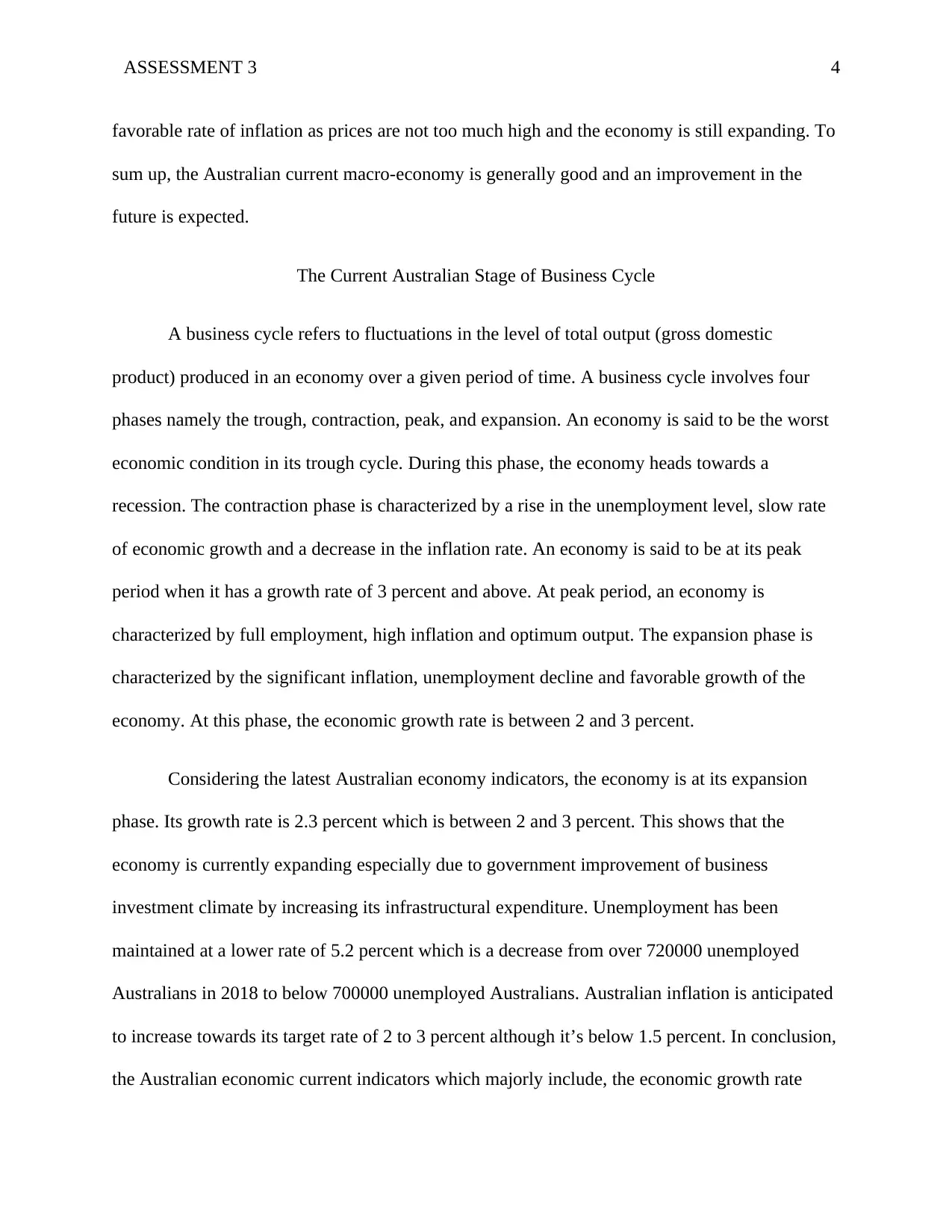
ASSESSMENT 3 4
favorable rate of inflation as prices are not too much high and the economy is still expanding. To
sum up, the Australian current macro-economy is generally good and an improvement in the
future is expected.
The Current Australian Stage of Business Cycle
A business cycle refers to fluctuations in the level of total output (gross domestic
product) produced in an economy over a given period of time. A business cycle involves four
phases namely the trough, contraction, peak, and expansion. An economy is said to be the worst
economic condition in its trough cycle. During this phase, the economy heads towards a
recession. The contraction phase is characterized by a rise in the unemployment level, slow rate
of economic growth and a decrease in the inflation rate. An economy is said to be at its peak
period when it has a growth rate of 3 percent and above. At peak period, an economy is
characterized by full employment, high inflation and optimum output. The expansion phase is
characterized by the significant inflation, unemployment decline and favorable growth of the
economy. At this phase, the economic growth rate is between 2 and 3 percent.
Considering the latest Australian economy indicators, the economy is at its expansion
phase. Its growth rate is 2.3 percent which is between 2 and 3 percent. This shows that the
economy is currently expanding especially due to government improvement of business
investment climate by increasing its infrastructural expenditure. Unemployment has been
maintained at a lower rate of 5.2 percent which is a decrease from over 720000 unemployed
Australians in 2018 to below 700000 unemployed Australians. Australian inflation is anticipated
to increase towards its target rate of 2 to 3 percent although it’s below 1.5 percent. In conclusion,
the Australian economic current indicators which majorly include, the economic growth rate
favorable rate of inflation as prices are not too much high and the economy is still expanding. To
sum up, the Australian current macro-economy is generally good and an improvement in the
future is expected.
The Current Australian Stage of Business Cycle
A business cycle refers to fluctuations in the level of total output (gross domestic
product) produced in an economy over a given period of time. A business cycle involves four
phases namely the trough, contraction, peak, and expansion. An economy is said to be the worst
economic condition in its trough cycle. During this phase, the economy heads towards a
recession. The contraction phase is characterized by a rise in the unemployment level, slow rate
of economic growth and a decrease in the inflation rate. An economy is said to be at its peak
period when it has a growth rate of 3 percent and above. At peak period, an economy is
characterized by full employment, high inflation and optimum output. The expansion phase is
characterized by the significant inflation, unemployment decline and favorable growth of the
economy. At this phase, the economic growth rate is between 2 and 3 percent.
Considering the latest Australian economy indicators, the economy is at its expansion
phase. Its growth rate is 2.3 percent which is between 2 and 3 percent. This shows that the
economy is currently expanding especially due to government improvement of business
investment climate by increasing its infrastructural expenditure. Unemployment has been
maintained at a lower rate of 5.2 percent which is a decrease from over 720000 unemployed
Australians in 2018 to below 700000 unemployed Australians. Australian inflation is anticipated
to increase towards its target rate of 2 to 3 percent although it’s below 1.5 percent. In conclusion,
the Australian economic current indicators which majorly include, the economic growth rate
Paraphrase This Document
Need a fresh take? Get an instant paraphrase of this document with our AI Paraphraser
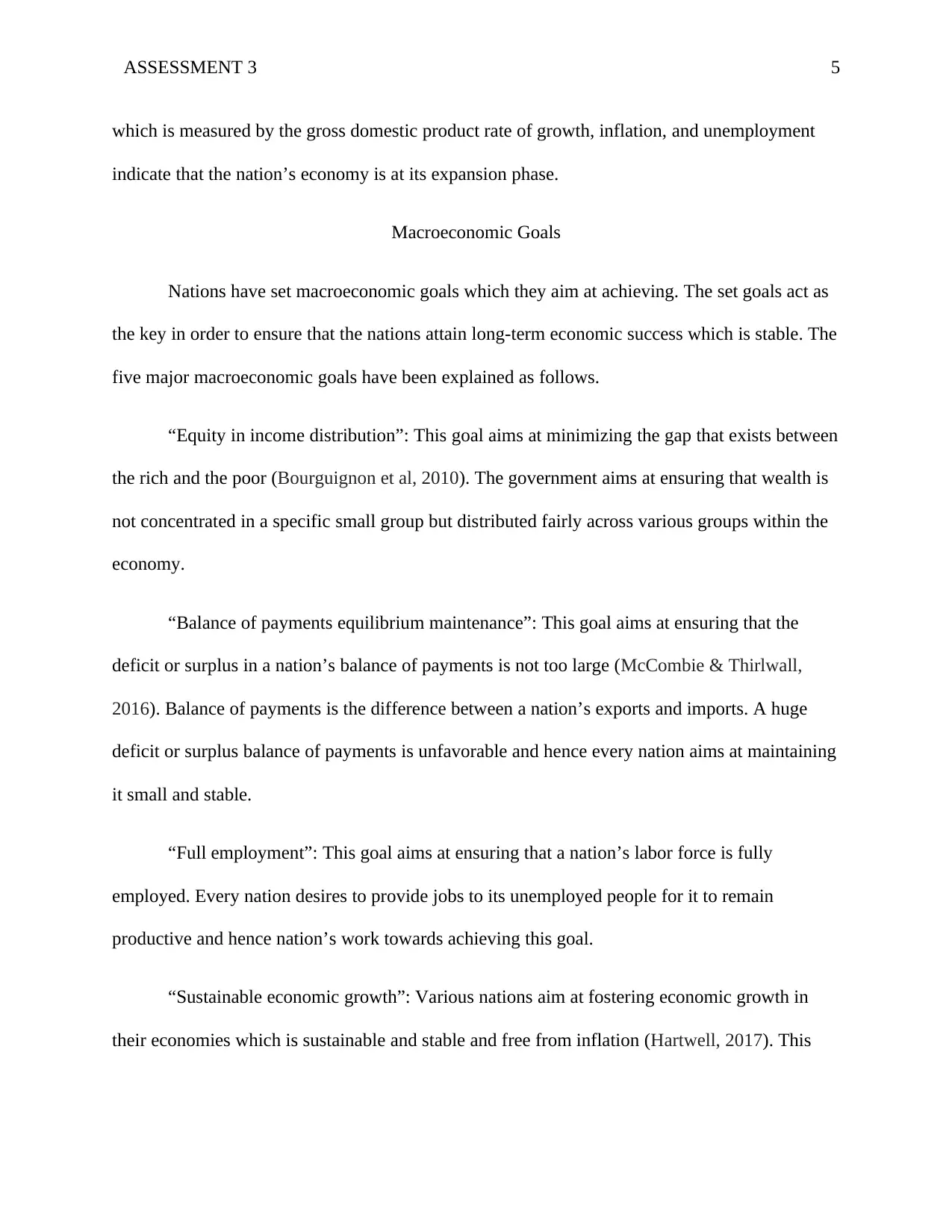
ASSESSMENT 3 5
which is measured by the gross domestic product rate of growth, inflation, and unemployment
indicate that the nation’s economy is at its expansion phase.
Macroeconomic Goals
Nations have set macroeconomic goals which they aim at achieving. The set goals act as
the key in order to ensure that the nations attain long-term economic success which is stable. The
five major macroeconomic goals have been explained as follows.
“Equity in income distribution”: This goal aims at minimizing the gap that exists between
the rich and the poor (Bourguignon et al, 2010). The government aims at ensuring that wealth is
not concentrated in a specific small group but distributed fairly across various groups within the
economy.
“Balance of payments equilibrium maintenance”: This goal aims at ensuring that the
deficit or surplus in a nation’s balance of payments is not too large (McCombie & Thirlwall,
2016). Balance of payments is the difference between a nation’s exports and imports. A huge
deficit or surplus balance of payments is unfavorable and hence every nation aims at maintaining
it small and stable.
“Full employment”: This goal aims at ensuring that a nation’s labor force is fully
employed. Every nation desires to provide jobs to its unemployed people for it to remain
productive and hence nation’s work towards achieving this goal.
“Sustainable economic growth”: Various nations aim at fostering economic growth in
their economies which is sustainable and stable and free from inflation (Hartwell, 2017). This
which is measured by the gross domestic product rate of growth, inflation, and unemployment
indicate that the nation’s economy is at its expansion phase.
Macroeconomic Goals
Nations have set macroeconomic goals which they aim at achieving. The set goals act as
the key in order to ensure that the nations attain long-term economic success which is stable. The
five major macroeconomic goals have been explained as follows.
“Equity in income distribution”: This goal aims at minimizing the gap that exists between
the rich and the poor (Bourguignon et al, 2010). The government aims at ensuring that wealth is
not concentrated in a specific small group but distributed fairly across various groups within the
economy.
“Balance of payments equilibrium maintenance”: This goal aims at ensuring that the
deficit or surplus in a nation’s balance of payments is not too large (McCombie & Thirlwall,
2016). Balance of payments is the difference between a nation’s exports and imports. A huge
deficit or surplus balance of payments is unfavorable and hence every nation aims at maintaining
it small and stable.
“Full employment”: This goal aims at ensuring that a nation’s labor force is fully
employed. Every nation desires to provide jobs to its unemployed people for it to remain
productive and hence nation’s work towards achieving this goal.
“Sustainable economic growth”: Various nations aim at fostering economic growth in
their economies which is sustainable and stable and free from inflation (Hartwell, 2017). This
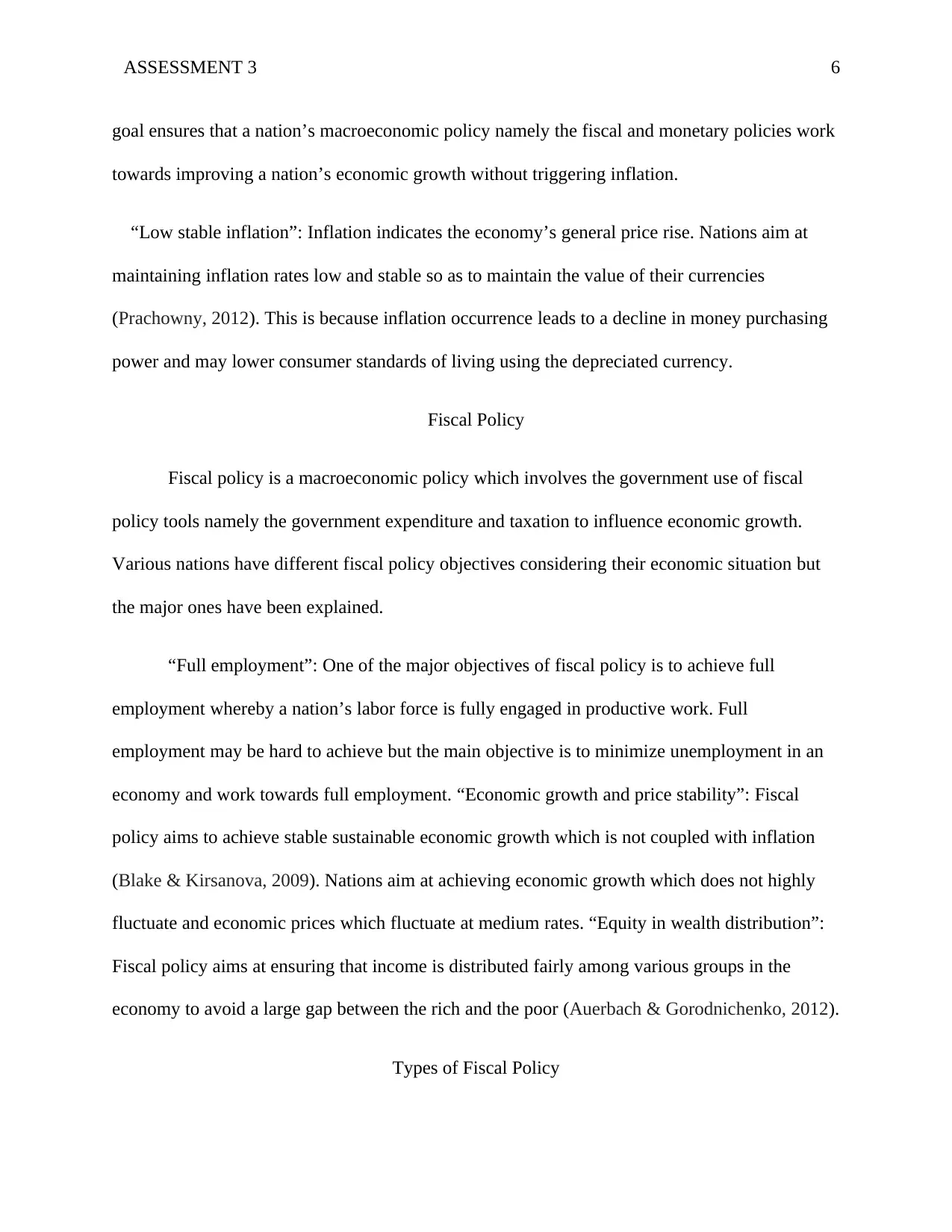
ASSESSMENT 3 6
goal ensures that a nation’s macroeconomic policy namely the fiscal and monetary policies work
towards improving a nation’s economic growth without triggering inflation.
“Low stable inflation”: Inflation indicates the economy’s general price rise. Nations aim at
maintaining inflation rates low and stable so as to maintain the value of their currencies
(Prachowny, 2012). This is because inflation occurrence leads to a decline in money purchasing
power and may lower consumer standards of living using the depreciated currency.
Fiscal Policy
Fiscal policy is a macroeconomic policy which involves the government use of fiscal
policy tools namely the government expenditure and taxation to influence economic growth.
Various nations have different fiscal policy objectives considering their economic situation but
the major ones have been explained.
“Full employment”: One of the major objectives of fiscal policy is to achieve full
employment whereby a nation’s labor force is fully engaged in productive work. Full
employment may be hard to achieve but the main objective is to minimize unemployment in an
economy and work towards full employment. “Economic growth and price stability”: Fiscal
policy aims to achieve stable sustainable economic growth which is not coupled with inflation
(Blake & Kirsanova, 2009). Nations aim at achieving economic growth which does not highly
fluctuate and economic prices which fluctuate at medium rates. “Equity in wealth distribution”:
Fiscal policy aims at ensuring that income is distributed fairly among various groups in the
economy to avoid a large gap between the rich and the poor (Auerbach & Gorodnichenko, 2012).
Types of Fiscal Policy
goal ensures that a nation’s macroeconomic policy namely the fiscal and monetary policies work
towards improving a nation’s economic growth without triggering inflation.
“Low stable inflation”: Inflation indicates the economy’s general price rise. Nations aim at
maintaining inflation rates low and stable so as to maintain the value of their currencies
(Prachowny, 2012). This is because inflation occurrence leads to a decline in money purchasing
power and may lower consumer standards of living using the depreciated currency.
Fiscal Policy
Fiscal policy is a macroeconomic policy which involves the government use of fiscal
policy tools namely the government expenditure and taxation to influence economic growth.
Various nations have different fiscal policy objectives considering their economic situation but
the major ones have been explained.
“Full employment”: One of the major objectives of fiscal policy is to achieve full
employment whereby a nation’s labor force is fully engaged in productive work. Full
employment may be hard to achieve but the main objective is to minimize unemployment in an
economy and work towards full employment. “Economic growth and price stability”: Fiscal
policy aims to achieve stable sustainable economic growth which is not coupled with inflation
(Blake & Kirsanova, 2009). Nations aim at achieving economic growth which does not highly
fluctuate and economic prices which fluctuate at medium rates. “Equity in wealth distribution”:
Fiscal policy aims at ensuring that income is distributed fairly among various groups in the
economy to avoid a large gap between the rich and the poor (Auerbach & Gorodnichenko, 2012).
Types of Fiscal Policy
⊘ This is a preview!⊘
Do you want full access?
Subscribe today to unlock all pages.

Trusted by 1+ million students worldwide
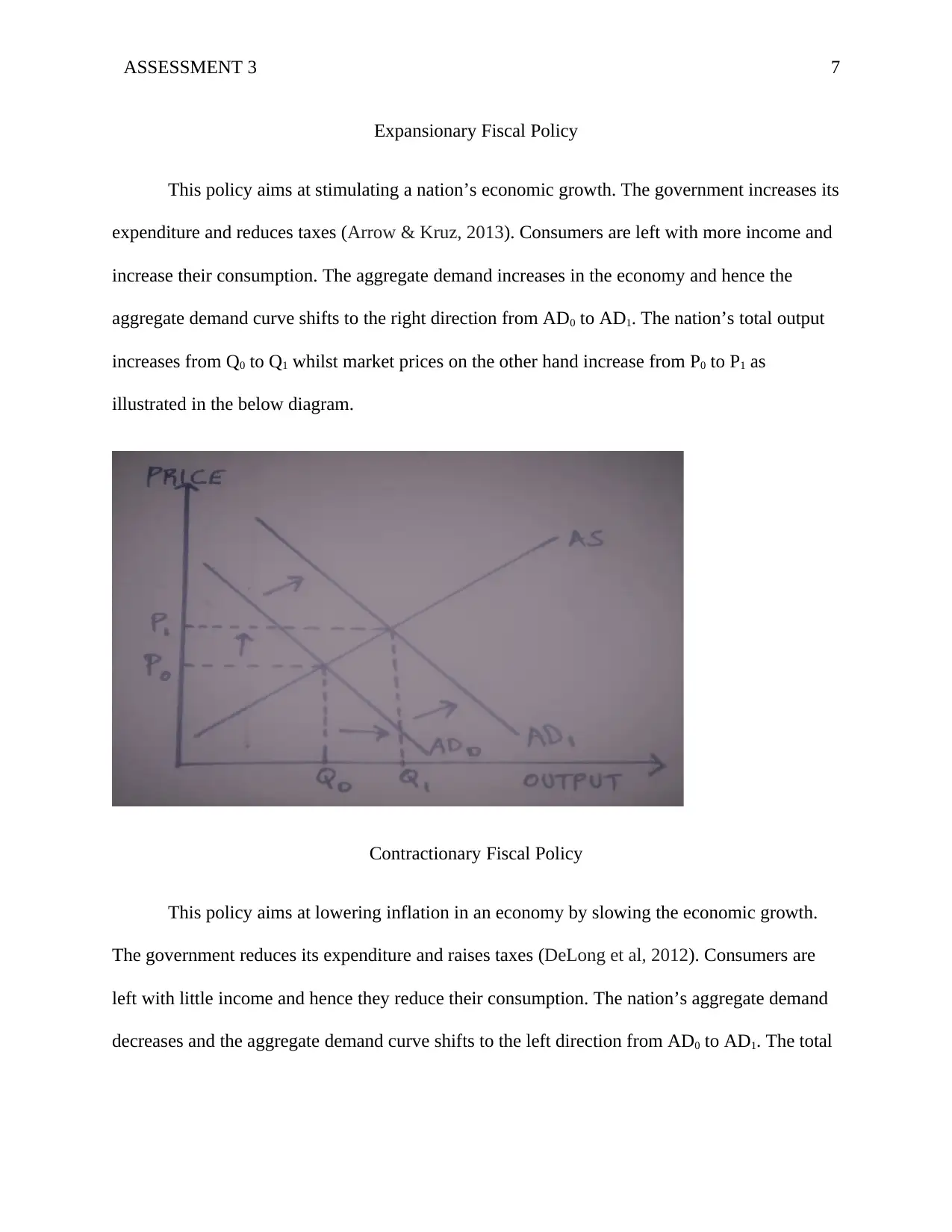
ASSESSMENT 3 7
Expansionary Fiscal Policy
This policy aims at stimulating a nation’s economic growth. The government increases its
expenditure and reduces taxes (Arrow & Kruz, 2013). Consumers are left with more income and
increase their consumption. The aggregate demand increases in the economy and hence the
aggregate demand curve shifts to the right direction from AD0 to AD1. The nation’s total output
increases from Q0 to Q1 whilst market prices on the other hand increase from P0 to P1 as
illustrated in the below diagram.
Contractionary Fiscal Policy
This policy aims at lowering inflation in an economy by slowing the economic growth.
The government reduces its expenditure and raises taxes (DeLong et al, 2012). Consumers are
left with little income and hence they reduce their consumption. The nation’s aggregate demand
decreases and the aggregate demand curve shifts to the left direction from AD0 to AD1. The total
Expansionary Fiscal Policy
This policy aims at stimulating a nation’s economic growth. The government increases its
expenditure and reduces taxes (Arrow & Kruz, 2013). Consumers are left with more income and
increase their consumption. The aggregate demand increases in the economy and hence the
aggregate demand curve shifts to the right direction from AD0 to AD1. The nation’s total output
increases from Q0 to Q1 whilst market prices on the other hand increase from P0 to P1 as
illustrated in the below diagram.
Contractionary Fiscal Policy
This policy aims at lowering inflation in an economy by slowing the economic growth.
The government reduces its expenditure and raises taxes (DeLong et al, 2012). Consumers are
left with little income and hence they reduce their consumption. The nation’s aggregate demand
decreases and the aggregate demand curve shifts to the left direction from AD0 to AD1. The total
Paraphrase This Document
Need a fresh take? Get an instant paraphrase of this document with our AI Paraphraser
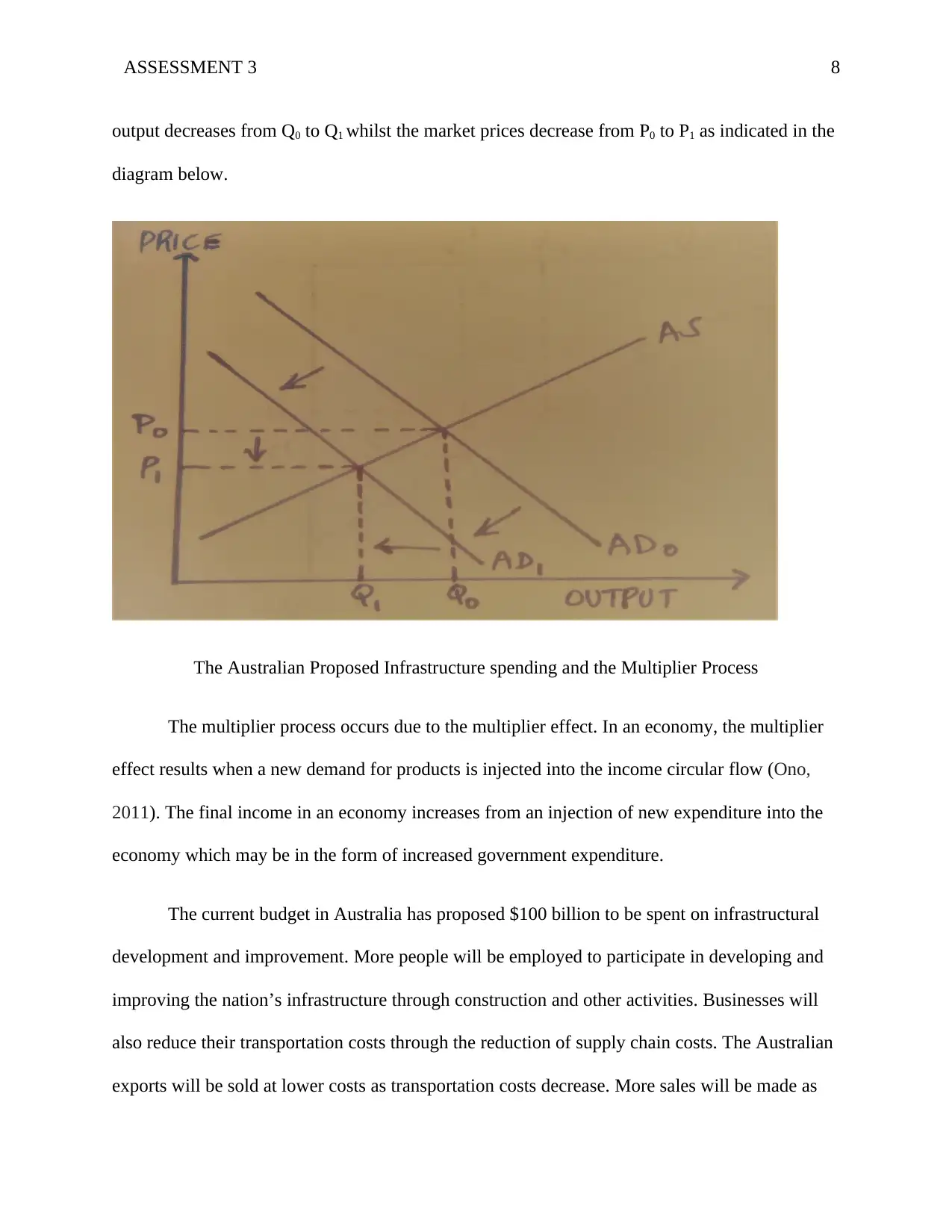
ASSESSMENT 3 8
output decreases from Q0 to Q1 whilst the market prices decrease from P0 to P1 as indicated in the
diagram below.
The Australian Proposed Infrastructure spending and the Multiplier Process
The multiplier process occurs due to the multiplier effect. In an economy, the multiplier
effect results when a new demand for products is injected into the income circular flow (Ono,
2011). The final income in an economy increases from an injection of new expenditure into the
economy which may be in the form of increased government expenditure.
The current budget in Australia has proposed $100 billion to be spent on infrastructural
development and improvement. More people will be employed to participate in developing and
improving the nation’s infrastructure through construction and other activities. Businesses will
also reduce their transportation costs through the reduction of supply chain costs. The Australian
exports will be sold at lower costs as transportation costs decrease. More sales will be made as
output decreases from Q0 to Q1 whilst the market prices decrease from P0 to P1 as indicated in the
diagram below.
The Australian Proposed Infrastructure spending and the Multiplier Process
The multiplier process occurs due to the multiplier effect. In an economy, the multiplier
effect results when a new demand for products is injected into the income circular flow (Ono,
2011). The final income in an economy increases from an injection of new expenditure into the
economy which may be in the form of increased government expenditure.
The current budget in Australia has proposed $100 billion to be spent on infrastructural
development and improvement. More people will be employed to participate in developing and
improving the nation’s infrastructure through construction and other activities. Businesses will
also reduce their transportation costs through the reduction of supply chain costs. The Australian
exports will be sold at lower costs as transportation costs decrease. More sales will be made as

ASSESSMENT 3 9
the exports become competitive internationally and hence Australian businesses will have to
employ more workers and expand their production to meet the increased demand for exports. As
more people are employed, consumers will have more income and hence they will increase their
consumption. The aggregate demand and the total output in the economy will increase as shown
below.
As indicated in the above diagram, the initial cash injection of $100 will increase the
Australian aggregate demand and the aggregate demand curve will shift from AD1 to AD2
initially. However, the other economic sectors will also benefit with time. This will shift the
demand curve further from AD2 to AD3 as expenditure by one individual is an income for
another party. The nation’s total output which is indicated by the real gross domestic product will
increase at last due to the multiplier process as shown in the above diagram.
The Australian Tax Cut Current Proposals and the Supply-side Effects
the exports become competitive internationally and hence Australian businesses will have to
employ more workers and expand their production to meet the increased demand for exports. As
more people are employed, consumers will have more income and hence they will increase their
consumption. The aggregate demand and the total output in the economy will increase as shown
below.
As indicated in the above diagram, the initial cash injection of $100 will increase the
Australian aggregate demand and the aggregate demand curve will shift from AD1 to AD2
initially. However, the other economic sectors will also benefit with time. This will shift the
demand curve further from AD2 to AD3 as expenditure by one individual is an income for
another party. The nation’s total output which is indicated by the real gross domestic product will
increase at last due to the multiplier process as shown in the above diagram.
The Australian Tax Cut Current Proposals and the Supply-side Effects
⊘ This is a preview!⊘
Do you want full access?
Subscribe today to unlock all pages.

Trusted by 1+ million students worldwide
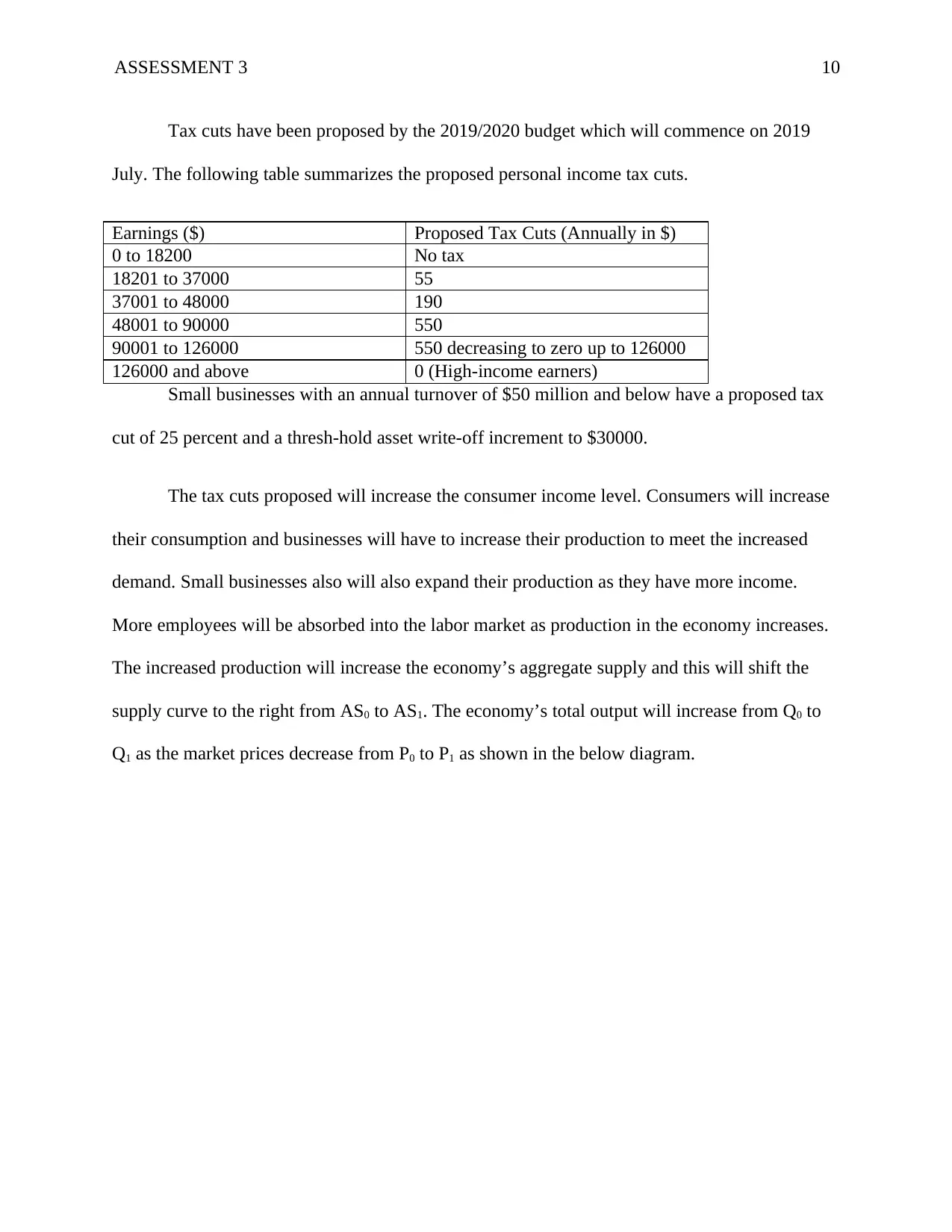
ASSESSMENT 3 10
Tax cuts have been proposed by the 2019/2020 budget which will commence on 2019
July. The following table summarizes the proposed personal income tax cuts.
Earnings ($) Proposed Tax Cuts (Annually in $)
0 to 18200 No tax
18201 to 37000 55
37001 to 48000 190
48001 to 90000 550
90001 to 126000 550 decreasing to zero up to 126000
126000 and above 0 (High-income earners)
Small businesses with an annual turnover of $50 million and below have a proposed tax
cut of 25 percent and a thresh-hold asset write-off increment to $30000.
The tax cuts proposed will increase the consumer income level. Consumers will increase
their consumption and businesses will have to increase their production to meet the increased
demand. Small businesses also will also expand their production as they have more income.
More employees will be absorbed into the labor market as production in the economy increases.
The increased production will increase the economy’s aggregate supply and this will shift the
supply curve to the right from AS0 to AS1. The economy’s total output will increase from Q0 to
Q1 as the market prices decrease from P0 to P1 as shown in the below diagram.
Tax cuts have been proposed by the 2019/2020 budget which will commence on 2019
July. The following table summarizes the proposed personal income tax cuts.
Earnings ($) Proposed Tax Cuts (Annually in $)
0 to 18200 No tax
18201 to 37000 55
37001 to 48000 190
48001 to 90000 550
90001 to 126000 550 decreasing to zero up to 126000
126000 and above 0 (High-income earners)
Small businesses with an annual turnover of $50 million and below have a proposed tax
cut of 25 percent and a thresh-hold asset write-off increment to $30000.
The tax cuts proposed will increase the consumer income level. Consumers will increase
their consumption and businesses will have to increase their production to meet the increased
demand. Small businesses also will also expand their production as they have more income.
More employees will be absorbed into the labor market as production in the economy increases.
The increased production will increase the economy’s aggregate supply and this will shift the
supply curve to the right from AS0 to AS1. The economy’s total output will increase from Q0 to
Q1 as the market prices decrease from P0 to P1 as shown in the below diagram.
Paraphrase This Document
Need a fresh take? Get an instant paraphrase of this document with our AI Paraphraser
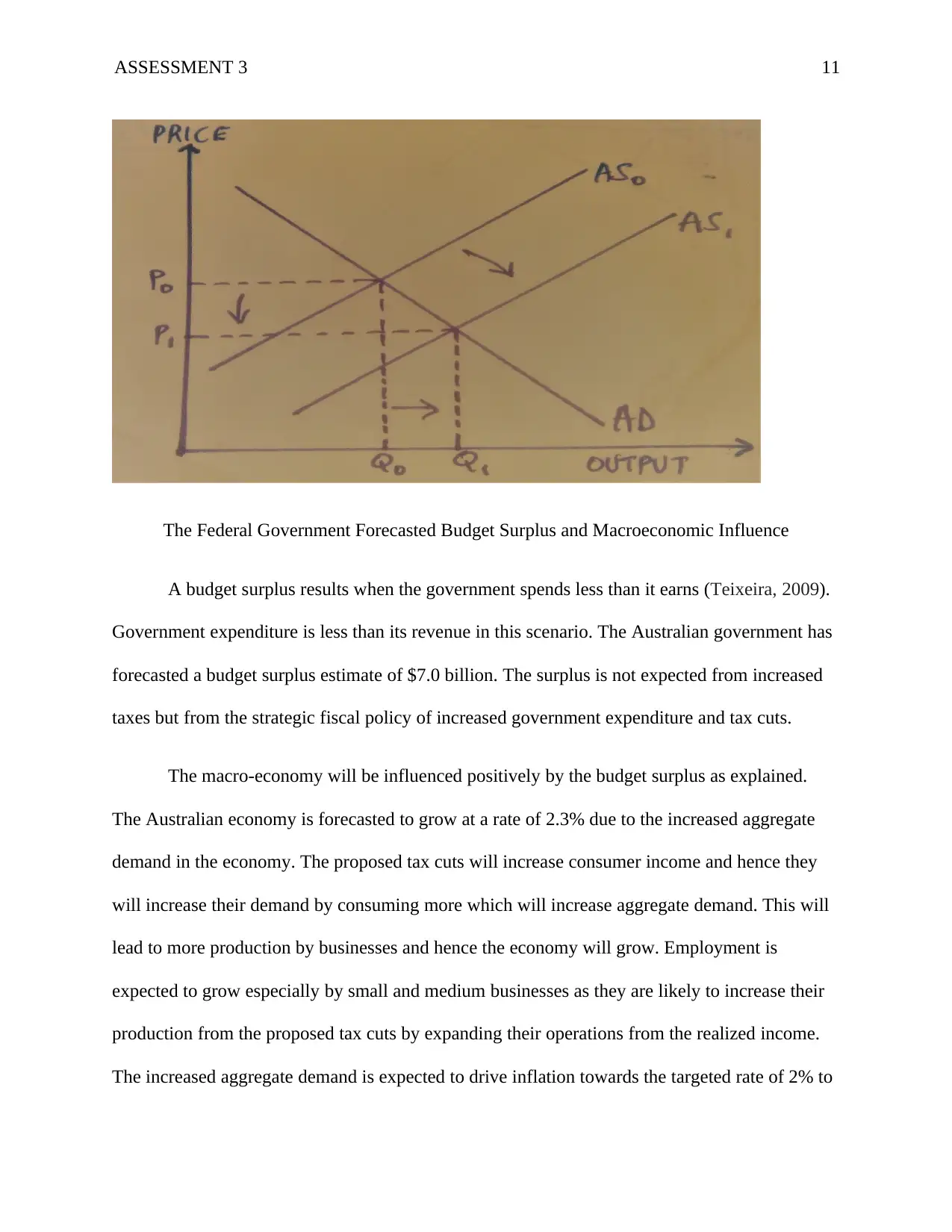
ASSESSMENT 3 11
The Federal Government Forecasted Budget Surplus and Macroeconomic Influence
A budget surplus results when the government spends less than it earns (Teixeira, 2009).
Government expenditure is less than its revenue in this scenario. The Australian government has
forecasted a budget surplus estimate of $7.0 billion. The surplus is not expected from increased
taxes but from the strategic fiscal policy of increased government expenditure and tax cuts.
The macro-economy will be influenced positively by the budget surplus as explained.
The Australian economy is forecasted to grow at a rate of 2.3% due to the increased aggregate
demand in the economy. The proposed tax cuts will increase consumer income and hence they
will increase their demand by consuming more which will increase aggregate demand. This will
lead to more production by businesses and hence the economy will grow. Employment is
expected to grow especially by small and medium businesses as they are likely to increase their
production from the proposed tax cuts by expanding their operations from the realized income.
The increased aggregate demand is expected to drive inflation towards the targeted rate of 2% to
The Federal Government Forecasted Budget Surplus and Macroeconomic Influence
A budget surplus results when the government spends less than it earns (Teixeira, 2009).
Government expenditure is less than its revenue in this scenario. The Australian government has
forecasted a budget surplus estimate of $7.0 billion. The surplus is not expected from increased
taxes but from the strategic fiscal policy of increased government expenditure and tax cuts.
The macro-economy will be influenced positively by the budget surplus as explained.
The Australian economy is forecasted to grow at a rate of 2.3% due to the increased aggregate
demand in the economy. The proposed tax cuts will increase consumer income and hence they
will increase their demand by consuming more which will increase aggregate demand. This will
lead to more production by businesses and hence the economy will grow. Employment is
expected to grow especially by small and medium businesses as they are likely to increase their
production from the proposed tax cuts by expanding their operations from the realized income.
The increased aggregate demand is expected to drive inflation towards the targeted rate of 2% to
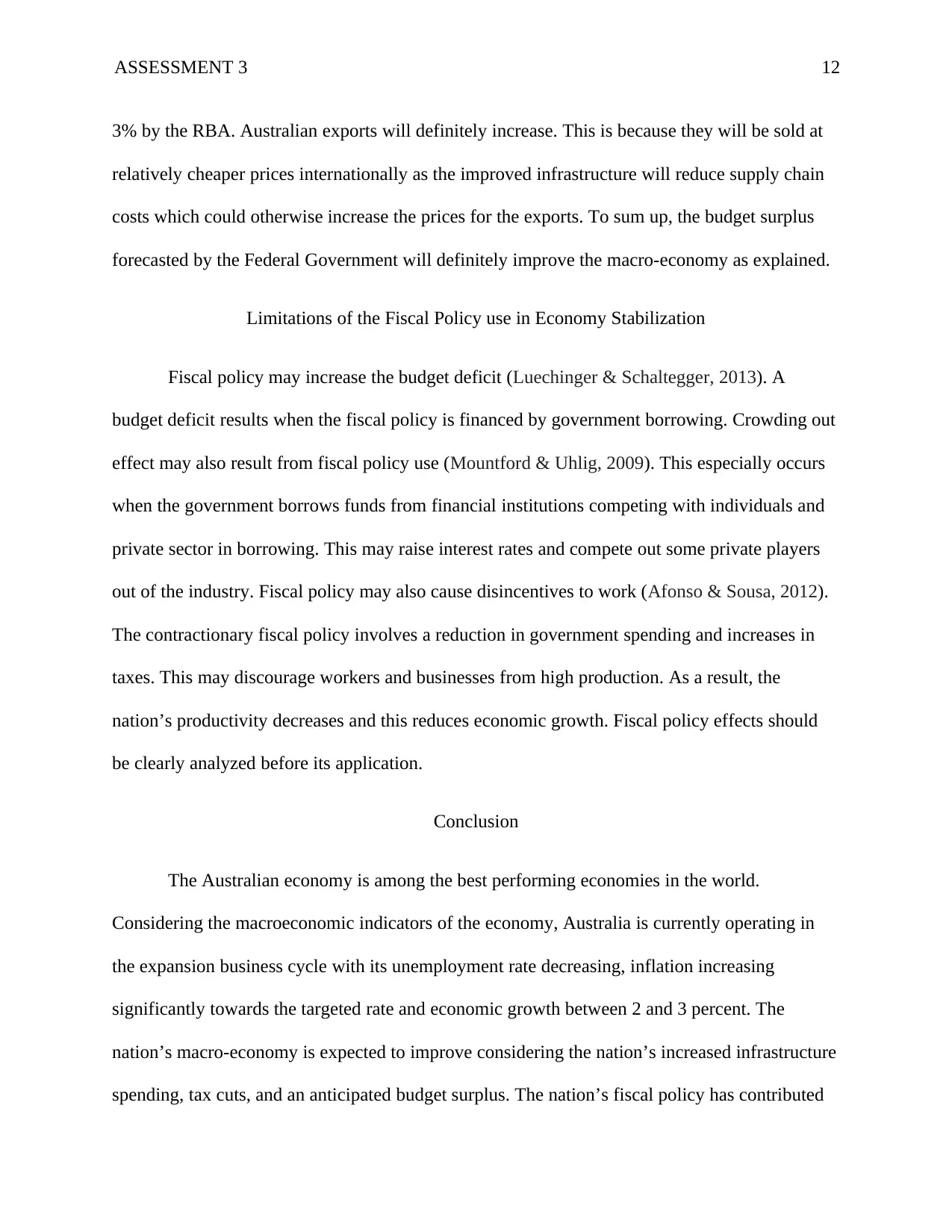
ASSESSMENT 3 12
3% by the RBA. Australian exports will definitely increase. This is because they will be sold at
relatively cheaper prices internationally as the improved infrastructure will reduce supply chain
costs which could otherwise increase the prices for the exports. To sum up, the budget surplus
forecasted by the Federal Government will definitely improve the macro-economy as explained.
Limitations of the Fiscal Policy use in Economy Stabilization
Fiscal policy may increase the budget deficit (Luechinger & Schaltegger, 2013). A
budget deficit results when the fiscal policy is financed by government borrowing. Crowding out
effect may also result from fiscal policy use (Mountford & Uhlig, 2009). This especially occurs
when the government borrows funds from financial institutions competing with individuals and
private sector in borrowing. This may raise interest rates and compete out some private players
out of the industry. Fiscal policy may also cause disincentives to work (Afonso & Sousa, 2012).
The contractionary fiscal policy involves a reduction in government spending and increases in
taxes. This may discourage workers and businesses from high production. As a result, the
nation’s productivity decreases and this reduces economic growth. Fiscal policy effects should
be clearly analyzed before its application.
Conclusion
The Australian economy is among the best performing economies in the world.
Considering the macroeconomic indicators of the economy, Australia is currently operating in
the expansion business cycle with its unemployment rate decreasing, inflation increasing
significantly towards the targeted rate and economic growth between 2 and 3 percent. The
nation’s macro-economy is expected to improve considering the nation’s increased infrastructure
spending, tax cuts, and an anticipated budget surplus. The nation’s fiscal policy has contributed
3% by the RBA. Australian exports will definitely increase. This is because they will be sold at
relatively cheaper prices internationally as the improved infrastructure will reduce supply chain
costs which could otherwise increase the prices for the exports. To sum up, the budget surplus
forecasted by the Federal Government will definitely improve the macro-economy as explained.
Limitations of the Fiscal Policy use in Economy Stabilization
Fiscal policy may increase the budget deficit (Luechinger & Schaltegger, 2013). A
budget deficit results when the fiscal policy is financed by government borrowing. Crowding out
effect may also result from fiscal policy use (Mountford & Uhlig, 2009). This especially occurs
when the government borrows funds from financial institutions competing with individuals and
private sector in borrowing. This may raise interest rates and compete out some private players
out of the industry. Fiscal policy may also cause disincentives to work (Afonso & Sousa, 2012).
The contractionary fiscal policy involves a reduction in government spending and increases in
taxes. This may discourage workers and businesses from high production. As a result, the
nation’s productivity decreases and this reduces economic growth. Fiscal policy effects should
be clearly analyzed before its application.
Conclusion
The Australian economy is among the best performing economies in the world.
Considering the macroeconomic indicators of the economy, Australia is currently operating in
the expansion business cycle with its unemployment rate decreasing, inflation increasing
significantly towards the targeted rate and economic growth between 2 and 3 percent. The
nation’s macro-economy is expected to improve considering the nation’s increased infrastructure
spending, tax cuts, and an anticipated budget surplus. The nation’s fiscal policy has contributed
⊘ This is a preview!⊘
Do you want full access?
Subscribe today to unlock all pages.

Trusted by 1+ million students worldwide
1 out of 15